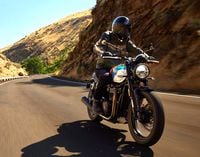Though it's a familiar term to pilots of light aircraft, few motorcyclists have heard of carburetor icing. It sounds like something that only happens on a cold day, but that's not the case. A carb can be blocked by venturi ice even on a warm day. The only requirement is a measure of humidity; the carburetor itself supplies the necessary cold.
As fuel vaporizes in the throat of the carburetor, it lowers the temperature of the passing air and the carb body. If there is moisture in that air, it can begin to freeze and stick to the venturi. And if it builds up sufficiently, it will obstruct the carburetor throat, causing the engine to run poorly or die. It can be very difficult to troubleshoot because by the time you have a chance to look into the carburetor, the ice has melted.
Some riders of Vulcan 1500 Classics suffered from a mysterious engine stoppage which, after much frustration (primarily in making it happen), the firm's engineers determined to be carb icing. Carbureted aircraft engines use a pilot-operated carb-heating device to prevent carb icing during low-throttle operations. Since a controllable system wasn't practical for motorcycle use, Kawasaki routed coolant hoses to the carburetor to keep the carb body warm as soon as the engine warmed.
The engine now has some extra black hoses blocking your view of the hardware. It’s a price most of us will happily pay to avoid having the engine suddenly sign off.
/cloudfront-us-east-1.images.arcpublishing.com/octane/2E5YMUXYPV3SXUJOHUL65IKCAE.jpg)
/cloudfront-us-east-1.images.arcpublishing.com/octane/DTN6JPXIQJFXPBR43K4GWBDYJ4.jpg)
/cloudfront-us-east-1.images.arcpublishing.com/octane/PDJNVOWK5VFEBKBUG32CWZEAFI.jpg)
/cloudfront-us-east-1.images.arcpublishing.com/octane/URZBW5LIV5BIXMBTOKHIDHMIPM.jpg)

/cloudfront-us-east-1.images.arcpublishing.com/octane/6KKT5NNL2JAVBOXMZYS5ZO76YA.jpg)
/cloudfront-us-east-1.images.arcpublishing.com/octane/H6Z2IC7WYRBXZNQS4MI3SZ5KPQ.jpg)
/cloudfront-us-east-1.images.arcpublishing.com/octane/IWO5T5PBT5E4HFQ5GK47H5YXR4.jpg)
/cloudfront-us-east-1.images.arcpublishing.com/octane/OQVCJOABCFC5NBEF2KIGRCV3XA.jpg)
/cloudfront-us-east-1.images.arcpublishing.com/octane/F3O2DGLA4ZBDJGNVV6T2IUTWK4.jpg)
/cloudfront-us-east-1.images.arcpublishing.com/octane/ZXYQE3MHLFDSPKNGWL7ER5WJ4U.jpg)
/cloudfront-us-east-1.images.arcpublishing.com/octane/RDF24VM7WVCOBPIR3V3R4KS63U.jpg)
/cloudfront-us-east-1.images.arcpublishing.com/octane/W7RSIBFISNHJLIJESSWTEBTZRQ.jpg)
/cloudfront-us-east-1.images.arcpublishing.com/octane/AERA26ENRNBW3K324YWCPEXYKM.jpg)
/cloudfront-us-east-1.images.arcpublishing.com/octane/YWX3YX7QBBHFXFDMEEEKRG4XJE.jpg)
/cloudfront-us-east-1.images.arcpublishing.com/octane/I7OKI53SZNDOBD2QPXV5VW4AR4.jpg)
/cloudfront-us-east-1.images.arcpublishing.com/octane/IH52EK3ZYZEDRD3HI3QAYOQOQY.jpg)
/cloudfront-us-east-1.images.arcpublishing.com/octane/K2FSAN7OWNAXRJBY32DMVINA44.jpg)
/cloudfront-us-east-1.images.arcpublishing.com/octane/G4XK7JL24FCUTKLZWUFVXOSOGE.jpg)
/cloudfront-us-east-1.images.arcpublishing.com/octane/JJNXVAC27ZCDDCMTHTQZTHO55Y.jpg)




